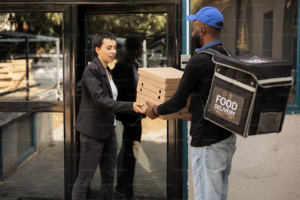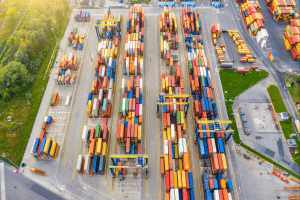Digital mapping and location intelligence is critical to the world economy. They facilitate efficient and sustainable movement of people, goods and services. Location information is the anchor for valuable insights into spatial relationships, patterns and trends.
Real-Time Insights
Logistic companies increasingly rely on access to a dynamic representation of their fleets on the road network to quickly react to unexpected events in the supply chain. A near real-time view of reality empowers fleet and supply chain managers to quickly react to events, maintain accurate estimated time of arrival (ETA) predictions on point, as well as continuously evaluate if better routes are available.
As governments focus on reducing logistics costs through unified interfaces and enabling policies, the integration of advanced technologies such as Location Services, AI, IoT, and data analytics will continue to unfold. These technologies have already started optimizing supply chain processes, enhancing real-time tracking, and improving overall efficiency.
In the coming year, we can expect a deeper integration of these technologies, leading to more intelligent and automated logistics operations. To best embrace spatial tech, organizations need to prioritize data supply and governance, systems integration and collaboration, internally as well as with external technology partners.
By leveraging cloud-based geospatial platforms, decision-makers gain access to near real-time insights that enable addressing business needs while advancing sustainable development goals. This requires a shift in mindset and investment in skills development, data literacy, and technology infrastructure.
Building a Greener World
From a sustainability perspective, location-aware applications can improve operational efficiency, and reduce fuel consumption, waste and environmental impact. Geospatial data helps city planners design cities and transportation systems that prioritize walkability, public transit, and green spaces, thereby reducing carbon emissions and enhancing quality of life.
Investing in research and development, supporting start-ups and entrepreneurs, and incentivizing cross-sector partnerships are crucial for driving innovation in the geospatial space.
It also helps support sustainable supply chain management by providing insights into fleet optimization throughout the first, middle, and last mile, while helping to measure the environmental impacts of sourcing and production processes.
Moreover, location intelligence enables businesses to dynamically adjust their supply chains in response to changing market conditions, disruptions, and risks. By analyzing real-time data on factors such as weather patterns and transportation infrastructure, companies can identify potential bottlenecks or vulnerabilities. Proactively re-route their supply chains to ensure continuity of operations.
Collaborative Transformation
As we observe geospatial thinking increasingly fostering among businesses and citizens, HERE is committed to helping unleash the true value of geospatial technology, data and information. We need to focus on opening market access to geospatial data and promoting an open ecosystem to foster collaboration between public and private sectors.
For instance, for the National Geospatial Policy of India to unlock full potential, it is essential to ensure equitable market practices that create a level playing field for all stakeholders.
Additionally, investing in research and development, supporting start-ups and entrepreneurs, and incentivizing cross-sector partnerships is crucial for driving innovation in the geospatial space. We strongly believe in collaborative transformation through open dialogue, partnerships, and technology innovation.
By providing flexible, reliable, and scalable digital mapping and location solutions, we aim to empower governments, businesses and communities with the capabilities needed to work towards common goals. International collaboration encourages the transfer of cutting-edge technologies and methodologies, which enhance the capabilities of companies and professionals.
Disclaimer: Views Expressed are Author's Own. Geospatial World May or May Not Endorse it








